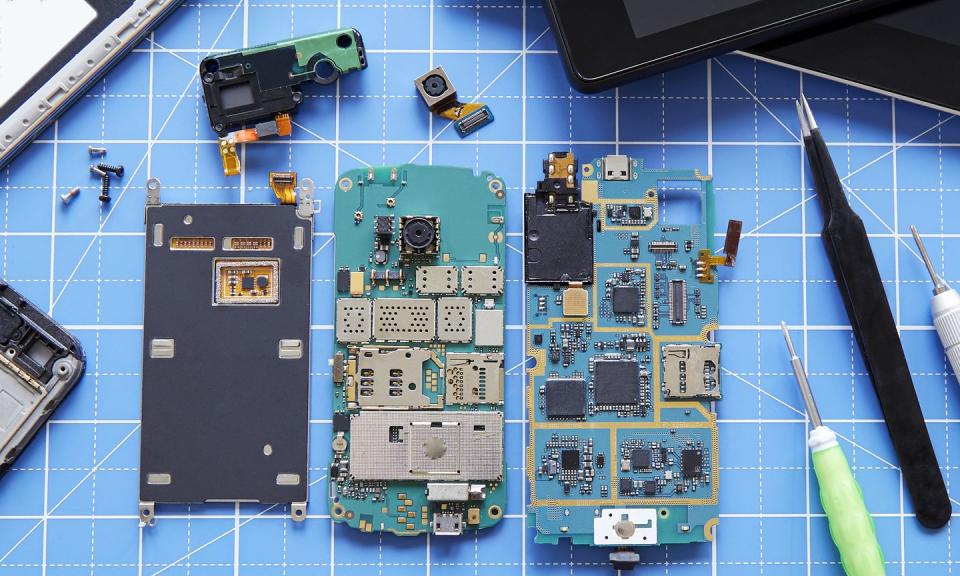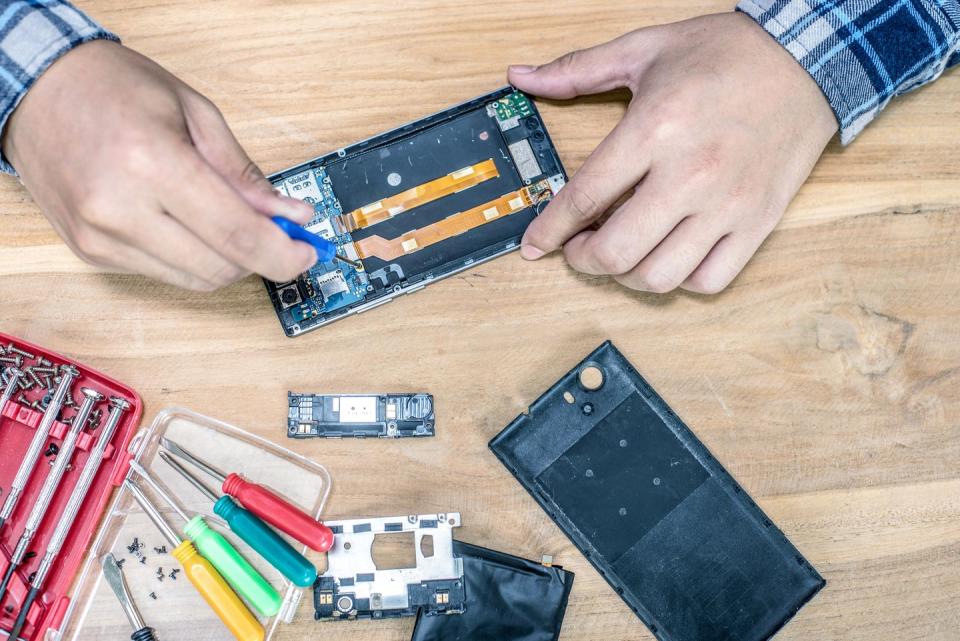This Guy Stacked 42 Broken PlayStation 4s... to Explain Why We Need Right-to-Repair Laws
"Hearst Magazines and Yahoo may earn commission or revenue on some items through the links below."
The right-to-repair movement is reaching a tipping point, with half of the states in the U.S. considering new laws.
Right-to-repair is meant to help consumers and third parties access tools for repairs, which most manufacturers have traditionally railed against.
Consumer electronics, farming technology, military equipment, and even ventilators are effected by it.
It's hard to explain how central the right-to-repair movement is in our everyday lives, perhaps with the exception of that junk drawer of defunct electronics you probably have at home. To make things a bit more visual, a YouTuber stacked 42 defunct PlayStation 4 consoles in a leaning tower, à la Jenga, to drive the point home. Without access to the necessary tools for fixing our devices, we're doomed to waste money and cram our landfills.
🔨 You love DIY projects. So do we. Let's get our hands dirty together.
"Want to watch me stack broken PS4s and see how high they get before they fall over?" YouTuber TronicsFix writes in the description for his October 5 video. "Whether you think this is a fun idea or a horrible idea, what I think we can all agree on is that Right-to-Repair is important for electronics."
The video (below) is part entertainment, part protest, and builds upon national momentum that the right-to-repair movement has seen this year. That includes the Fair Repair Act, a new house bill in support of right-to-repair, proposed in June; President Joe Biden's July 9 executive order, outlining efforts to make it "easier and cheaper" to repair your own items; and a U.S. Federal Trade Commission (FTC) report that found "there is scant evidence to support manufacturers' justifications for repair restrictions." An investigation of that matter is ongoing.
What Is the Right-to-Repair Movement?
Why should you care? Think about all the items you own that can break—smartphones, earbuds, video game consoles, and more. Some of these items are truly unfixable, and in fact, are often voided for warranties if you even open their cases. If your Nintendo Switch controllers begin to "drift," for instance, you must send them back to Nintendo only. If your flatscreen television breaks, many manufacturers will tell you to simply throw it away and replace it.
This is because the United States doesn't have legislation in place that guarantees consumers the right to repair. Advocates for right-to-repair say this has led to an economy of disposability where these kinds of consumer electronics are concerned. People can't make money working as independent repairers of consumer goods (companies like Apple only work with certain "authorized service providers"), eliminating the entire livelihood of repair for certain industries. And if people can't get their goods repaired, the resale value of those items falls to almost zilch.
Making products repairable involves a minimal amount of extra work for companies. This, again, is easy to imagine—instead of phones that are completely sealed shut, manufacturers would need to add tiny screws (or some other manner of entry) to allow access to the phone's internal electronics. They'd have to begin selling the parts that third parties need in order to complete repairs, setting up systems like the ones used in car repair.
A Brief History of the Right-to-Repair Movement

How did we get here? It's actually only been this difficult to repair your own devices for the past 25 years, after a critical piece of law expired and reopened the idea of repair monopolies—the term insiders use to refer to the opposite of right-to-repair. IBM was found to be a monopoly in 1956, and the U.S. Department of Justice hung a threat over their heads in the form of a document called the IBM Consent Decree.
After the Consent Decree expired in 1996, IBM was allowed to reestablish a repair monopoly that had been illegal since 1956. After that, the rest of the industry followed, and other industries followed that. The advocacy group Repair Association estimates that 90 percent of manufacturers have monopolies on repairs to their items. The organization began advocating for new right-to-repair policies in 2013, and have continued to gain momentum ever since.
The good news is that repair monopolies are still fairly new, and legislators have begun to push back with right-to-repair bills on the state and national level. In March, Vice reported that half of U.S. states were considering their own right-to-repair laws. Why is 2021 such a huge pivot point for right-to-repair? It's at least partly because of the COVID-19 pandemic.
Right-to-Repair Isn't All About Consumer Electronics
It's easy to think of right-to-repair as primarily affecting our consumer electronics, because those things inconvenience the most people, and are highly relatable—think about how arduous it is to get an iPhone repaired without voiding the warranty. But farmers have huge repair interests, for example, and a problematic case relating to public health emerged during the pandemic, as Popular Mechanics previously reported in April 2020:
Hospitals are having a difficult time servicing their existing ventilators, and biomedical technicians, who repair hospital equipment, are already stretched thin.
While third-party technicians could theoretically step in and rehab the devices, manufacturers have put arbitrary "software locks" on the ventilators, ensuring only authorized parties can modify or service them.
Manufacturers have clamped down even further by keeping service manuals close to the vest. In one case, the German ventilator manufacturer Dräger actually sent cease-and-desist letters to the website Frank's Hospital Workshop, which publicly posted the manuals.
After New York became the first state senate to vote for right-to-repair legislation in June, Congressman Joe Morelle (D-NY) introduced the Fair Repair Act in the House. "This common-sense legislation will help make technology repairs more accessible and affordable for items from cell phones to laptops to farm equipment, finally giving individuals the autonomy they deserve," Morelle said in a statement.
What Is the Fair Repair Act?

The proposed law will require manufacturers to make far more information and parts available to third parties, making repairs much more similar to car repairs; you can take your broken thing to the nearest competent shop (or even do the work yourself), without having to solely rely on the manufacturer.
Farm equipment stands out as a specific example, because farmers have flocked to older tractors that are still repairable. John Deere made headlines by promising to make information available to repair their newer models by 2021, which it subsequently failed to do. In the wake of this fiasco, states in the breadbasket region began to fight back against repair monopolies.
In July, the FTC voted 5-0 in favor of creating a new plan to investigate and support right-to-repair. All of this means the future looks pretty bright for tinkerers and DIYers. Hopefully, industry players will cooperate and hand back the tools of their trades to consumers and repair professionals. Until then, we'll just have to keep stacking up our PlayStations.
Additional reporting by Courtney Linder
🎥 Now Watch This:
You Might Also Like

